#Java Script Development
Explore tagged Tumblr posts
Text
Discover the top programming languages poised to dominate app development in 2024.
0 notes
Text
Java in Depth, become a complete Java Engineer

tart your journey into the world of Computer Science with a beginner-to-advanced course covering core concepts like Programming (C, C++, Python), Data Structures, Algorithms, Operating Systems, Database Management, Computer Networks, and emerging fields like Artificial Intelligence and Machine Learning.
This course is ideal for students aiming to build a solid foundation in software development, data analytics, or IT careers. With hands-on learning and expert guidance, it prepares you for real-world challenges in tech.
Students from Uttam Nagar and Yamuna Vihar looking to gain practical skills in computer science can benefit greatly from this industry-relevant training program. Join now to turn your tech passion into a profession!
Visit Attitude Academy
📚 Learn Computer Science: Attitude Academy
📍 Visit Us: Yamuna Vihar | Uttam Nagar
📞 Call: +91 9654382235
🌐 Website: www.attitudetallyacademy.com
📩 Email: [email protected]
📸 Follow us on: attitudeacademy4u
#computer science course in yamuna vihar#computer science course in uttam nagar#c programming language#C++ programmin course#python training in yamuna vihar#java script course in uttam nagar#web development course
0 notes
Text
Writing smarter Drupal code starts with package.json
package.json is not just a dependency tracker but a powerful tool for efficiency, automation, and scalability in Node.js and Drupal projects. Learn how to make the most of it by understanding its properties and how to use it in Drupal.

0 notes
Text
20 - CART - Session Id | Cookie | Middleware - (Next js 15, React 19, PostgreSQL , Prisma, ShadCN, Paypal, Stripe API integration) https://youtu.be/fBlodyl-75g
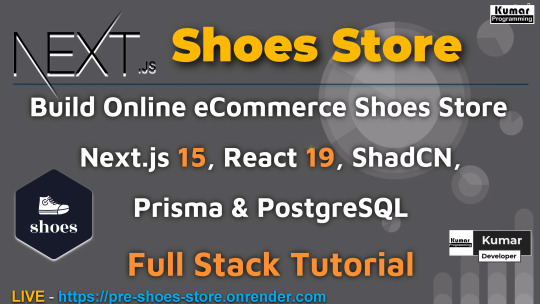












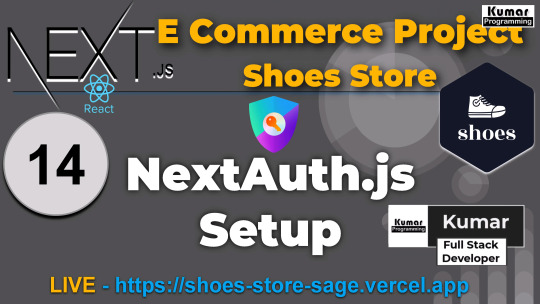

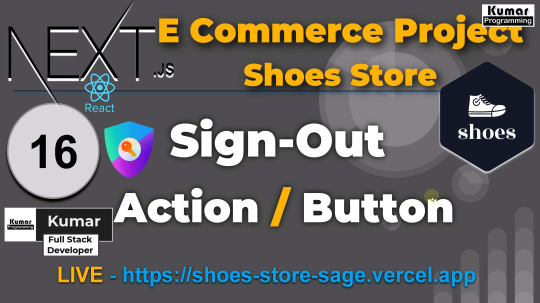
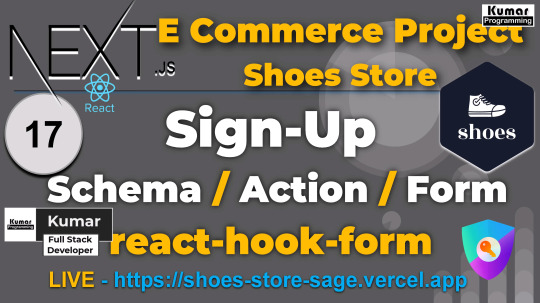


#education#programming#angular#react#softwarecompany#webdeveloper#nodejs#youtube#developer#tech#next js#react js#java script
1 note
·
View note
Text
#Learn Java#Java course#Java developer#Java script#Java certification#Java ide#Java programming#Java tutor#Jms#Jdk#Java online course#Java development kit#Java developer course#Learn Java programming#Java certification course#Java coding#Java jdk#Learn Java online#Java for beginners
0 notes
Text

🚀 Join eMexo Technologies for an exclusive Front End Training starting December 16, 2024. 💻🌟
💡 What makes us different?
✅ Practical, hands-on training ✅ Expert trainers with real-world experience ✅ Job support, mock interviews, & live projects
✨ New Batch Alert:
📅 When: December 16, 2024 ( Tomorrow ) ⏰ Time: 05.00 PM ( IST ) 💻 Mode: Classroom Training 📍 Where: eMexo Technologies
🌐 Don't miss this opportunity to advance your career. Limited seats available—enroll now!
👉 CLICK https://www.emexotechnologies.com/ to register today! ✍️
📞 Call us at +91 9513216462 for more info.
#emexotechnologies#bangalore#electroniccity#traininginstitute#education#learning#course#training#careers#techeducation#front end#front end development#html css#java script#reactjs#techskills#skillup#careerdevelopment#career growth
0 notes
Text
Cutting-Edge IoT Applications: Harnessing JavaScript and Machine Learning
The combination of JavaScript and machine learning (ML) is driving innovation in the Internet of Things (IoT), creating powerful applications that enhance everyday life. Here are some exciting examples of how these technologies work together:
1. Smart Home Systems
Using JavaScript and ML, developers can create smart home devices that learn from user behavior. For example, a smart lighting system can adjust brightness and color based on the time of day or user preferences, making homes more comfortable and energy-efficient.
2. Healthcare Monitoring
Wearable health devices can utilize JavaScript and ML to analyze data in real-time. These devices can track vital signs and activity levels, sending alerts to users or healthcare providers when abnormalities are detected. This proactive approach to health management can improve outcomes and facilitate timely interventions.
3. Automated Agriculture
In agriculture, IoT sensors gather data on soil conditions, weather patterns, and crop health. JavaScript can be used to visualize this data, while ML algorithms analyze it to provide farmers with recommendations on irrigation, fertilization, and pest control, optimizing crop yields and resource use.
4. Smart Cities
Cities are implementing IoT solutions to improve urban living. For instance, smart traffic management systems use data from sensors and cameras to optimize traffic flow. JavaScript can be used to create dashboards that help city planners visualize traffic patterns and make data-driven decisions to reduce congestion.
5. Personalized Retail Experiences
In retail, IoT devices can track customer behavior in stores. By using JavaScript and ML, businesses can analyze this data to offer personalized promotions and product recommendations, enhancing the shopping experience and increasing sales.
6. Enhanced Security Systems
IoT security cameras can employ ML to differentiate between normal activities and potential threats. JavaScript can provide a user-friendly interface for monitoring these systems, enabling users to receive real-time alerts and access video feeds easily.
Conclusion
Innovative IoT applications using JavaScript and machine learning are transforming various sectors, from smart homes to healthcare and agriculture. By harnessing these technologies, developers can create solutions that improve efficiency, enhance user experiences, and drive better decision-making. As the IoT landscape evolves, the collaboration between JavaScript, machine learning, and IoT will continue to unlock new possibilities for the future, leading to even more innovative IoT applications using JavaScript and machine learning.
1 note
·
View note
Text

Hire Dedicated AngularJS Developers | Custom Web Development Solutions | AIS Technolabs
Hire dedicated AngularJS developers to build high-performance, scalable web applications. Our team delivers custom solutions tailored to your business needs. Start your project with us today.
0 notes
Text

How To Create A Statistic Counter For Your Website Using HTML, CSS & JavaScript — Sohojware
Do you ever wonder how many visitors your website attracts? Or perhaps you’re curious about how many times a specific button is clicked? Website statistics counters provide valuable insights into user behavior, and statistic counters are a fantastic way to visualize this data. In this comprehensive guide by Sohojware, we’ll delve into creating a basic statistic counter using HTML, CSS, and JavaScript.
This guide is tailored for users in the United States who want to enhance their website with an engaging statistic counter. Whether you’re a seasoned developer or just starting out, this tutorial will equip you with the necessary steps to implement a statistic counter on your website.
Why Use a Statistic Counter?
Website statistic counters offer a multitude of benefits. Here’s a glimpse into why they’re so valuable:
Track Visitor Engagement: Statistic counters provide real-time data on how many visitors your website receives. This information is crucial for understanding your website’s traffic patterns and gauging its overall effectiveness.
Monitor User Interaction: By placing statistic counters strategically on your website (e.g., near buttons or downloads), you can track how often specific elements are interacted with. This allows you to identify areas that resonate with your audience and areas for improvement.
Boost User Confidence: Well-designed statistic counters can showcase the popularity of your website, fostering trust and credibility among visitors. Imagine a counter displaying a high number of visitors — it subconsciously assures users that they’ve landed on a valuable resource.
Motivate Action: Strategic placement of statistic counters can encourage visitors to take desired actions. For instance, a counter displaying the number of downloads for a particular resource can entice others to download it as well.
Setting Up the Project
Before we dive into the code, let’s gather the necessary tools:
Text Editor: Any basic text editor like Notepad (Windows) or TextEdit (Mac) will suffice. For a more feature-rich experience, consider code editors like Visual Studio Code or Sublime Text.
Web Browser: You’ll need a web browser (e.g., Chrome, Firefox, Safari) to view the final result.
Once you have these tools ready, let’s create the files for our project:
Create a folder named “statistic-counter”.
Within the folder, create three files:
Building the HTML Structure
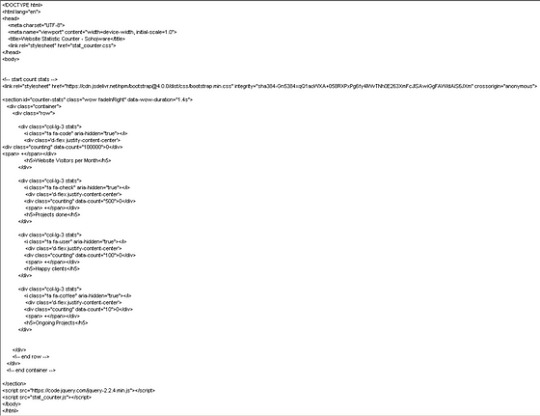
Let’s break down the code:
DOCTYPE declaration: Specifies the document type as HTML.
HTML tags: The and tags define the root element of the HTML document.
Lang attribute: Specifies the document language as English (en).
Meta tags: These tags provide metadata about the webpage, including character encoding (charset=UTF-8) and viewport configuration (viewport) for optimal display on various devices.
Title: Sets the title of the webpage displayed on the browser tab as “Website Statistic Counter — Sohojware”.
Link tag: Links the external CSS stylesheet (style.css) to the HTML document.
Body: The tag contains the content displayed on the webpage.
Heading: The tag creates a heading element with the text “Website Statistic Counter”.
Counter container: The element with the ID “counter-container” serves as a container for the counter itself.
Counter span: The element with the ID “counter” displays the numerical value of the statistic counter. The initial value is set to 0.
Script tag: The tag references the external JavaScript file (script.js), which will contain the logic for updating the counter
Styling the Counter
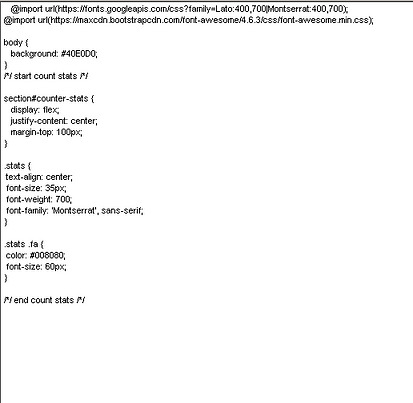
Let’s break down the CSS styles:
Body: Sets the font family for the entire body and centers the content.
Heading: Adds a bottom margin to the heading for better spacing.
Counter container: Styles the container with a border, padding, width, and centers it horizontally.
Counter: Sets the font size and font weight for the counter element, making it prominent.
Implementing the JavaScript Logic

Let’s break down the JavaScript code:
Variable declaration: Declares variables counter and count. counter references the HTML element with the ID “counter”, and count stores the current counter value.
updateCounter function: Defines a function named updateCounter that increments the count variable and updates the text content of the counter element.
setInterval: Calls the updateCounter function every 1000 milliseconds (1 second), creating a continuous update effect.
Running the Counter
Save all the files and open the index.html file in your web browser. You should see a webpage with the heading “Website Statistic Counter” and a counter that increments every second.
Customization and Enhancements
This is a basic example of a statistic counter. You can customize it further by:
Changing the counter speed: Modify the setInterval interval to adjust how frequently the counter updates.
Adding a start/stop button: Implement a button to start and stop the counter.
Displaying different units: Instead of a raw number, display the counter in units like “views” or “downloads”.
Integrating with analytics tools: Connect the counter to analytics tools like Google Analytics to track more detailed statistics.
Styling the counter: Experiment with different CSS styles to customize the appearance of the counter.
FAQs
1. Can I use a statistic counter to track specific events on my website?
Yes, you can. By placing statistic counters near buttons or links, you can track how often those elements are clicked or interacted with.
2. How often should I update the counter?
The update frequency depends on your specific use case. For a real-time counter, updating every second might be suitable. For less frequent updates, you can increase the interval.
3. Can I customize the appearance of the counter?
Absolutely! You can modify the CSS styles to change the font, color, size, and overall appearance of the counter.
4. Is it possible to integrate a statistic counter with other website elements?
Yes, you can integrate statistic counters with other elements using JavaScript. For example, you could display the counter value within a specific section or trigger other actions based on the counter’s value.
5. How can I ensure the accuracy of the statistic counter?
While JavaScript can provide a reliable way to track statistics, it’s essential to consider potential limitations. Factors like browser caching, ad blockers, and user scripts can influence the accuracy of the counter. If you require highly accurate statistics, it’s recommended to use server-side tracking mechanisms or analytics tools.
By following these steps and exploring the customization options, you can create a dynamic and informative statistic counter that enhances your website’s user experience and provides valuable insights into your audience’s behavior.
#sohojware#web development#web design#appsdevelopment#software development#css#html#java script#programming languages
1 note
·
View note
Text
5 Most Popular Backend Frameworks for Web App Development

The development of web applications has progressed significantly since the era of manual coding of every aspect from the beginning. Backend frameworks enable developers to optimize the development process and construct resilient applications within a shorter time frame. The present blog entry will expound upon the five prevalent backend frameworks that are currently in vogue for the creation of web applications. In order to assist you in ascertaining the most suitable framework for your project, we shall delve extensively into the framework’s characteristics, advantages, and applications. If you are also in search of prevalent frontend frameworks, we recommend perusing the 5 most exceptional Frontend Frameworks for Web Development in 2023.
Node.js — Build scalable server-side applications with this framework
Node.js is a framework that is utilized for the development of scalable server-side applications. It helps developers with an event-driven, non-blocking I/O model which makes it perfect for creating highly efficient and performant web applications.
What are Core Features of Node.js?
With Node.js, you get an event-driven, non-blocking I/O model; it has built-in database support, with many libraries. Data-intensive asynchronous and real-time applications can benefit from event-driven architecture. Built-in support for popular databases like MySql, Mongo, and many others simplifies development by eliminating the need to write custom code.
When to Use Node.js for Building Applications?
Node.js is a preferred choice for creating highly scalable server-side applications for handling a huge amount of data. Additionally, its event-driven architecture makes it perfect for building real-time and asynchronous applications. And finally, its built-in support for popular databases simplifies the development process by eliminating the need to write custom code.
Django- Web Development Framework based on Python
Web applications can be quickly and easily created with the help of Django framework. It is a Python-based web framework. Django has built-in support for many popular databases like SQL, MySQL, and many libraries, as well as an extensive collection of components like forms, widgets, view controllers, and more.
What are the Core Features of Django?
The features of Django includes an object-relational mapper (ORM), template engine, authentication, internationalization support, extensibility, authorization, serialization, and caching. The ORM simplifies database operations by providing an easier way to interact with the database. The template engine allows developers to quickly create dynamic webpages using powerful templating features like variables, loops, and more. Authentication provides a secure way of identifying users, while internationalization support helps developers easily create localized applications.
When to Use Django for Building Applications?
Django is the perfect choice for creating comprehensive web applications with minimal effort. Its ORM simplifies database operations while its template engine makes it easier to create dynamic webpages.
Ruby on Rails — Streamlines the process of building websites
ROR is an MVC-based web framework for developing dynamic and fully-featured web applications. It provides developers with an intuitive workflow that simplifies the development process considerably.
What are the Core Features of ROR?
The core features of ROR are Model-View-Controller (MVC) architecture, database migrations, object-relational mapper (ORM), and extensive library support. The MVC architecture helps developers easily separate the business logic from the presentation layer. Database migrations make it easier to work with databases, while the ORM simplifies database operations. And finally, extensive libraries help developers quickly create powerful web applications with minimal effort.
Ascertaining the Suitable Scenarios for Utilizing Ruby on Rails in Web Development.
Ruby on Rails is an ideal choice for creating feature-rich and data-driven applications. Its intuitive workflow streamlines the development process considerably, while its built-in support for popular databases simplifies the process of setting up and managing databases. Additionally, its extensive libraries make it perfect for quickly creating powerful web applications with minimal effort.
Laravel — The Open-Source Framework For PHP Development
Laravel is an open-source PHP based web framework for creating feature-rich and large-scale applications easily. It provides developers with an intuitive workflow that simplifies the development process considerably.
What are the Core Features of Laravel?
Laravel work on Model-View-Controller (MVC) architecture, an Eloquent ORM, a routing system, authentication, and extensibility which helps developer to develop a strong and scalable software. The MVC architecture helps developers easily separate the business logic from the presentation layer. The Eloquent ORM simplifies database operations while the routing system makes it easier to create routes and handle requests. Additionally, authentication provides a secure way of identifying users, while extensibility helps developers easily customize their applications.
READ MORE- https://www.precisio.tech/5-most-popular-backend-frameworks-for-web-app-development/
#technology#searchengineoptimization#seo#business#softwaredevelopment#marketing#it services#ai#artificialintelligence#socialmediamarketing#java script#programming#python#web development
0 notes
Text

Top 4 JavaScript Frameworks to Choose in 2024
🚀 Dive into the world of JavaScript frameworks with our latest post: "Top 4 JavaScript Frameworks to Choose in 2024"! Whether you're a seasoned developer or just starting out, staying updated on the latest tools is crucial. Check out our recommendations to streamline your development process and stay ahead of the curve. From React to Vue and beyond, we've got you covered. Let's make 2024 the year of efficient coding! 💻✨
0 notes
Text
React JS is a potent JavaScript library that has completely revolutionised the web development industry. Developed by Facebook in 2011, it is one of the most widely used front-end frameworks. Read on why React JS is the best option for creating web applications.
The technology is exceptionally adaptable and efficient from both a development and usage perspective.
0 notes
Text

Uncodemy presents its Java course in Greater Noida, providing a comprehensive avenue for mastering Java at your own pace. Java, a versatile and widely utilized programming language renowned for its speed, security, and reliability, is the focus of Uncodemy's course. The program in Greater Noida emphasizes innovative teaching techniques, top-notch training, intelligent classes, and extends job assistance to ensure promising opportunities for participants. Covering fundamental Java components such as the Java Development Kit (JDK), Java Virtual Machine (JVM), and Java Runtime Environment (JRE), Uncodemy's Java course equips students with the knowledge and skills essential for a successful career in Java development.
#java#java language#java developers#java script#java programming#best java course#online java classes#java training course#java training
0 notes
Text
Reytech Infoways: Crafting Digital Excellence for Your Business
In the rapidly evolving digital landscape, a strong online presence is the cornerstone of success for businesses across industries. At Reytech Infoways, we take pride in being the architects of digital excellence, dedicated to delivering cutting-edge web development solutions that elevate your brand and drive results.
Our Commitment to Tailored Solutions
Recognizing the uniqueness of every business, Reytech Infoways is committed to providing tailored web development solutions that align with your specific needs and goals. Whether you're a startup aiming for a powerful market entry or an established enterprise seeking a digital transformation, our team of seasoned developers is equipped to turn your vision into a compelling online reality.
Embracing the Latest Technologies for Future-Ready Websites
In a landscape where technology evolves rapidly, staying ahead is not a choice but a necessity. Reytech Infoways prides itself on its proactive approach to adopting the latest technologies and frameworks. From responsive design to progressive web apps, we leverage state-of-the-art tools to ensure that your website not only meets today's standards but is also poised to adapt to future innovations.
User-Centric Design for Immersive Experiences
Beyond aesthetics, we understand the critical importance of user experience. Our development process prioritizes creating intuitive and seamless interfaces, fostering an immersive journey for your visitors. A user-centric design approach is at the core of our philosophy, ensuring that your audience remains engaged from the first interaction to conversion.
Performance Optimization: Speed and Reliability
In the fast-paced digital world, speed is of the essence. Reytech Infoways places a strong emphasis on performance optimization to ensure that your website not only looks impressive but loads swiftly and operates efficiently. This commitment to speed and reliability contributes not only to a positive user experience but also to bolstering your search engine rankings.
Security: Safeguarding Your Digital Assets
The security of your website and the sensitive data it handles is our top priority. Reytech Infoways implements robust security measures, including SSL encryption, secure coding practices, and regular audits, to provide a secure digital environment for your business and your customers.
Seamless Integration and Scalability
As your business evolves, so should your digital presence. Reytech Infoways' web development services are designed with scalability in mind, allowing for seamless integration of new features and functionalities. Whether it's e-commerce capabilities, third-party integrations, or custom plugins, we ensure that your website remains a dynamic and powerful asset.
Collaboration and Transparent Communication
At Reytech Infoways, we believe in the power of collaboration. Throughout the development process, we maintain open lines of communication, ensuring that you are informed and involved at every stage. Your feedback is not only valued but is integral to the success of the project.
Embark on a Journey of Digital Excellence with Reytech Infoways
Your business deserves a web development partner that understands your aspirations and has the expertise to turn them into reality. Reytech Infoways invites you to embark on a journey of digital excellence. Contact us today, and let's build something extraordinary together – a website that not only meets the demands of today but anticipates the challenges of tomorrow.
#web development#web developers#web developing company#app development#app developers#android developer#ios development#flutter app development#react native app development company#java developers#angular development services#java script#magento development#node js development company#php development#react js development company#vue js development#wordpress development#blockchain development#devops development company#django development#python development
1 note
·
View note
Text
Job-assured Training Program by DOCC Kolkata
PHP, MySQL, and Laravel and Python and Django training programs with live projects for placements, offered by DOCC Kolkata. The training is for offline classes starting soon and admissions are currently open. I'd like to know if interested students are encouraged to contact the provided phone number (9433526196) for more information.
Web design training offered by DOCC Kolkata. Learning HTML, CSS, JavaScript, Bootstrap, and other related technologies like Javascript-Angular-react JS, etc., is essential for becoming a proficient web designer. It's important for individuals interested in web design to receive proper training and guidance to build their skills. If interested, contact 9433526196.
Visit www.docckolkata.com
#php programming#php training#phpwebsitedevelopment#php framework#php#coding#phpdevelopment#web development#web design#websites#python#programming#software engineering#machine learning#angular#react js#java script#laravel#training#placements#projects
0 notes